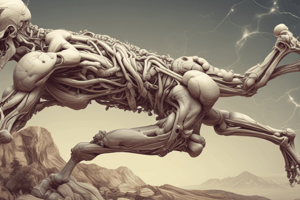Podcast
Questions and Answers
What is the study of the microscopic features of the body?
What is the study of the microscopic features of the body?
- Embryology
- Systemic anatomy
- Macroscopic anatomy
- Microscopic anatomy (correct)
Which term describes the study of body functions?
Which term describes the study of body functions?
- Cytology
- Anatomy
- Histology
- Physiology (correct)
What are the six levels of organization in the body?
What are the six levels of organization in the body?
Chemical, Cellular, Tissue, Organ, Organ System, Organism
The thoracic cavity contains the _______ and _______.
The thoracic cavity contains the _______ and _______.
The median plane separates the body into the front and back parts.
The median plane separates the body into the front and back parts.
What is the anatomical term for 'near the origin'?
What is the anatomical term for 'near the origin'?
What is the primary focus of neuroanatomy?
What is the primary focus of neuroanatomy?
The _______ is the smallest unit of life.
The _______ is the smallest unit of life.
What is the anatomical term for the back of the body?
What is the anatomical term for the back of the body?
Flashcards are hidden until you start studying
Study Notes
Anatomy Overview
- Anatomy refers to the study of body parts, derived from 'ana' (apart) and 'tomy' (to cut).
- Macroscopic anatomy examines the human body without instruments, while microscopic anatomy requires tools like a microscope.
Types of Anatomy
-
Macroscopic Anatomy
- Systemic Anatomy: Studies various body systems.
- Regional Anatomy: Focuses on specific body regions.
- Surface Anatomy: Analyzes structures based on body landmarks.
-
Microscopic Anatomy
- Cytology: Involves the study of individual cells.
- Histology: Studies the structure of tissues.
-
Embryology: Examines human body development from fertilization.
-
Neuroanatomy: Analyzes the nervous system's structure and development.
Physiology Overview
- Physiology pertains to normal body functions, describing how the body operates.
Types of Physiology
- Cell Physiology: Focuses on the functions of living cells.
- Special Physiology: Concerns the functions of specific organs.
- Systemic Physiology: Analyzes functions related to specific organ systems.
- Pathologic Physiology: Examines the impact of diseases on organ systems.
Levels of Organization
- Chemical Level: Atoms are the smallest unit.
- Cellular Level: Cells serve as the basic unit of life, containing organelles.
- Tissue Level: Groups of similar cells collaborate for common functions.
- Organ Level: Tissues combine to form organs with specific functions.
- Organ System Level: Organs work together for broader functions.
- Organism Level: All organ systems function in harmony.
Body Regions
- Head: Houses the brain and five senses (optic, acoustic, olfactory).
- Neck: Connects the head to the trunk, known as the cervical region.
- Trunk:
- Thorax: Contains heart and lungs.
- Abdomen: Includes most digestive and urinary organs.
- Pelvic Cavity: Houses reproductive organs and distal digestive parts.
- Upper Extremities: Comprising shoulders, arms, forearms, and hands.
- Lower Extremities: Includes hips, thighs, legs, and feet.
Body Planes
- Anatomical Position: Standing erect and supine position.
- Anatomical Planes:
- Median Plane: Divides the body into left and right halves.
- Sagittal Plane: Separated right and left parts.
- Coronal Plane: Splits the body into anterior and posterior sections.
- Horizontal Plane: Divides into superior (upper) and inferior (lower) parts.
Medical Terminology
- Octomy: Refers to cutting or opening.
- Itis: Indicates inflammation.
- Ectomy: Signifies removal.
General Anatomical Terms
- Superior (Cranial): Above.
- Inferior (Caudal): Below.
- Ventral (Anterior): Front.
- Dorsal (Posterior): Back.
- Proximal: Near to origin.
- Distal: Far from origin.
- Superficial: Closer to the skin’s surface.
- Deep: Further away from the surface.
Terms of Movement
- Flexion/Hyperextension: Bending or straightening joints.
- Extension: Straightening or increasing the angle.
- Abduction: Movement away from the midline.
Additional Anatomical Terms
- Facial: Relates to the face.
- Frontal: Refers to the forehead.
- Acromial: Pertains to the shoulder.
- Popliteal: Located behind the knee.
- Gluteal: Refers to the buttocks.
Studying That Suits You
Use AI to generate personalized quizzes and flashcards to suit your learning preferences.





